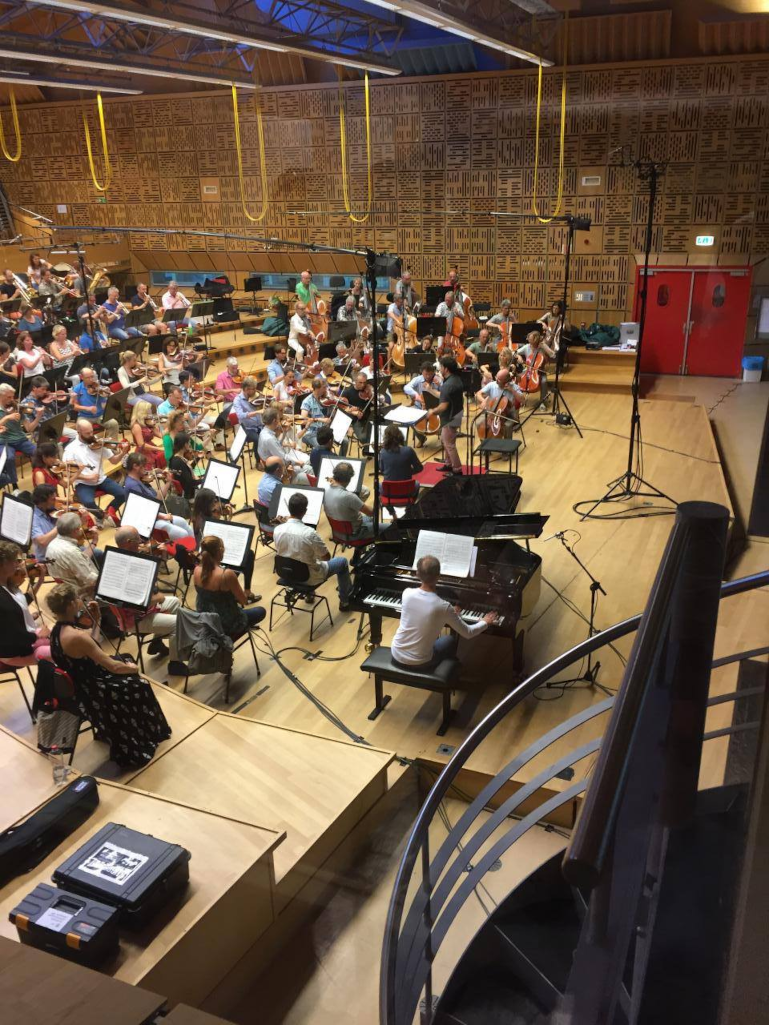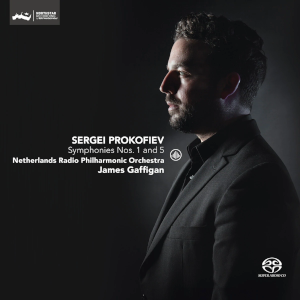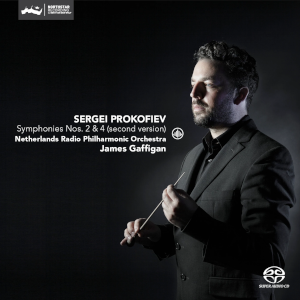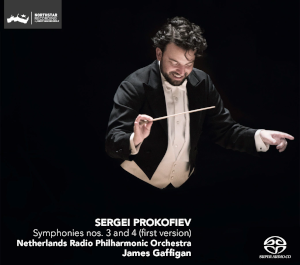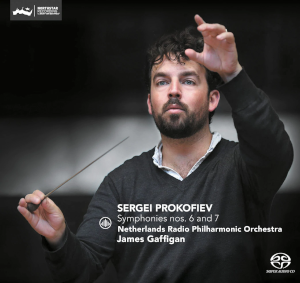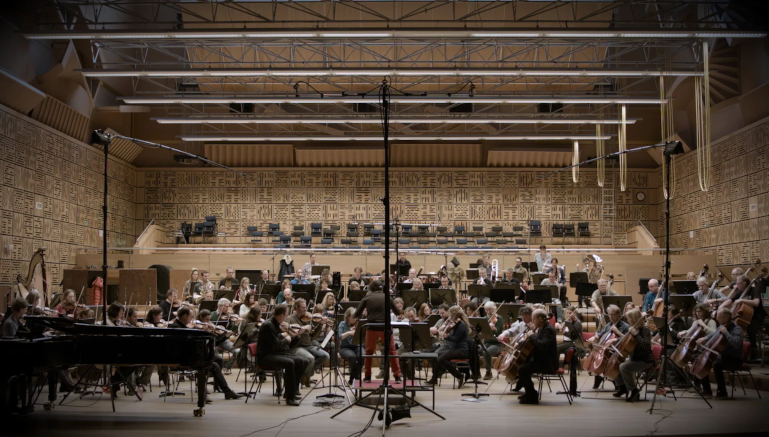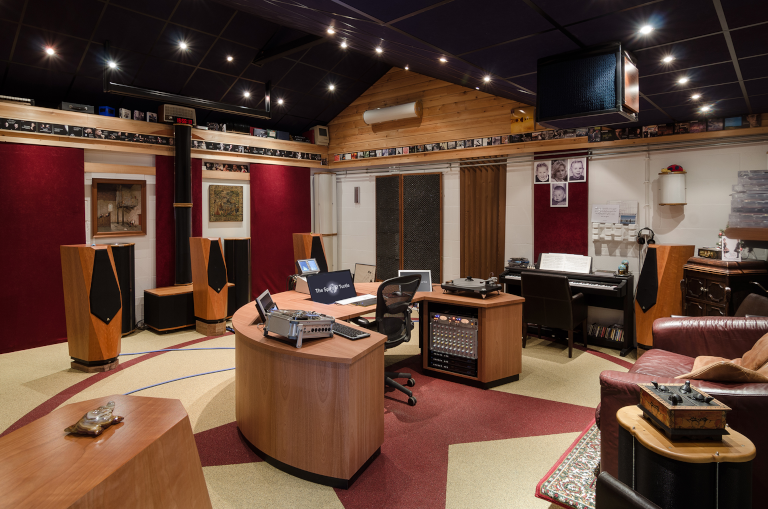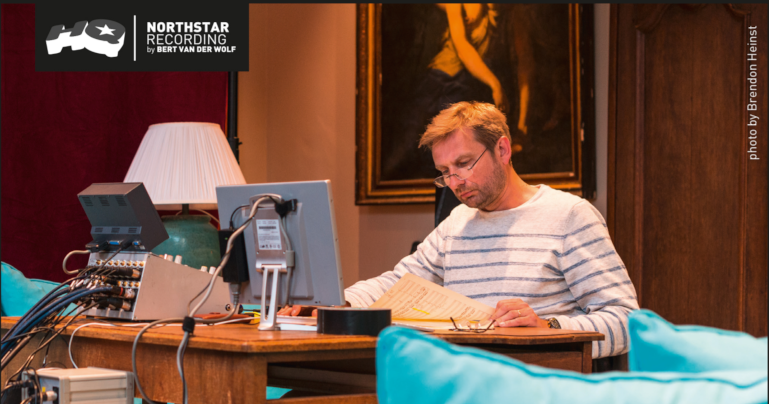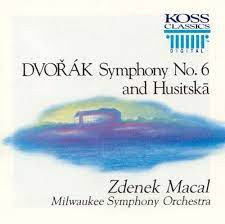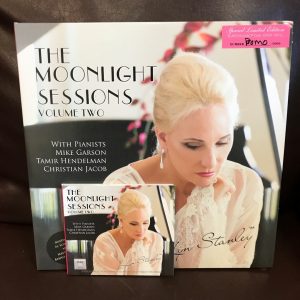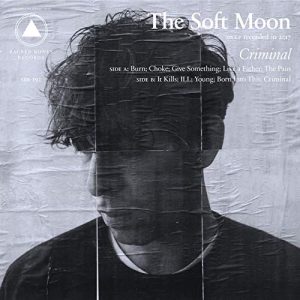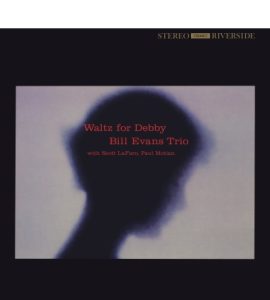James Gaffigan and the Netherlands Radio Philharmonic Orchestra deliver a very fine Prokofiev symphonies cycle. Collectively, these performances present a consistent and insightful look into Prokofiev's symphonic music, all exceedingly well executed. And all are recorded in the finest, most natural, sound quality one can find.
The Symphonies of Sergei Prokofiev, James Gaffigan, Netherlands Radio Philharmonic Orchestra. Challenge Records | Northstar Recording 2015, 2016, 2018 (DXD, DSD256) HERE
The conventional wisdom is to buy individual recordings by various conductors and orchestras to build a "best in class" cycle of a given composer's works. I don't disagree, but there is a further consideration.
By listening to an integral cycle from a single conductor one benefits from hearing that conductor's overall perspective of the composer in question. That single perspective in itself provides musical insights for a listener, plus it helps inform one about the benefits (or not) of certain other performances. In the case of this Prokofiev cycle from James Gaffigan and The Netherlands Radio Philharmonic Orchestra, I suggest we may have the benefits of both: consistent perspective and best in class performances.
Gaffigan seems to have a particular affinity for Prokofiev. His selection by Challenge Records to take on this cycle was an inspired choice and he has given us an inspired series of performances. In the process, Gaffigan has developed a high creative synergy with the Netherlands Radio Philharmonic Orchestra who perform at the level of a top world orchestra in these recordings. Gaffigan seems to have a thorough understanding and love for Prokofiev. And he is a persuasive advocate for these works.
Overall, the symphonies of his integral cycle are performed with great passion, ardor, and insight. Gaffigan delivers immense orchestral color yet never loses clarity, inner detail, and sense of direction. There is much to be learned from listening to these performances. And to be enjoyed!
About this cycle and Prokofiev's music in general, Gaffigan comments:
"I love Prokofiev because I think there's a little bit of everything in his music. There's elegance, there's absurdity, there's love, there's passion...there's all of these things within his music. And you can find it in all of his symphonies. He likes to have a good time with the listener; playing with their emotions, their comfort level. And that's by shocking them—setting up a beautiful melody and then all of a sudden the absurdities come out. The absurd characters come jumping out and they almost attack you at times.
"It's also clear that he has a very specific voice. Like Sibelius, like Mozart, like Haydn, you know when it's Prokofiev.
"Prokofiev is perfect for our time. He shocks us with the brutality of life. He shocks us with the beauty of life. He was a very smart man and I think he knew how to play with the listener, and how to play with the musician who is playing his composition. Prokofiev's set of symphonies go from the elegant to the absurd, sometimes within a single phrase. And I think that is very much how life is today...
"It is very interesting if you look at Prokofiev's life how he came back to beauty within music. The first symphony of course celebrates beauty and purity and the history of music--the masters of the past—while adding his own voice. The second was almost too brutal for the public to enjoy and it was a disaster for him. And he felt it and it took him many years to recover from that. And then later on, coming to the seventh symphony, he settles into a world where the melody is the most important thing—this incredibly tonal melody. And there is no fight to be "original" any more. He's absolutely himself.
"This was an incredible experience from beginning to end. Not just for me personally, but for my relationship with the orchestra. Exploring these symphonies within a three year period was very beneficial to our relationship, our chemistry, our trust, and our understanding of Prokofiev as a composer. Often we get to record one symphony within many symphonies, or record one concerto with a soloist that we like working with or something. In this case, from beginning to end, it was a project that developed within itself. I think it started out great and ended even better. I'm glad we have a document of this for the world to listen to."
YouTube - James Gaffigan discusses recording all of Prokofiev's Symphonies
Below I'll offer just a few comments about each of the albums from this cycle. They are not in order of release nor of recording date, just in symphony number order for the first symphony on the album.
- Prokofiev Symphonies, Nos. 1 & 5 – James Gaffigan
- Prokofiev Symphonies, Nos. 2 & 4 (second version) – James Gaffigan
- Prokofiev Symphonies, Nos. 3 & 4 (first version) – James Gaffigan
- Prokofiev Symphonies, Nos. 6 & 7 – James Gaffigan
- Comments about producer and recording engineer Bert van der Wolf
Prokofiev Symphonies, Nos. 1 & 5, James Gaffigan, Netherlands Radio Philharmonic Orchestra. Challenge Records | Northstar Recording 2015 (DXD, DSD256) HERE
From the opening bars, one feels something quite special going on in this performance. There is just a "rightness" to the dynamics and the pacing. Maestro Gaffigan certainly adheres to the tempo markings, there is no self-indulgent emphasis, but it's not needed. The more I listen, the more this opening movement sounds right. Perhaps I should say "simple and right," for this is the impression I get in listening to this performance of the "Classical" Symphony (1917). By keeping things simple, keeping the pacing steady and sure, a nice alternative impression of this music is revealed, differentiating it from the dozens of other performances in the catalog.
The subtitle "Classical" is the composer's own. Prokofiev stated, "I wanted to write a symphony that Haydn or Mozart would have written had they lived in the twentieth century… Classical music with a few wrong notes here and there."
Does this now become my favorite performance of the Classical Symphony? Hmmm, no, there are still others I greatly enjoy. But it does enhance my understanding of the music, it is a very nice performance, and it is by a long way the best sounding of the various performances I know.
This album continues with Symphony No. 5 (1944), so immediately in this album we get two of the most popular Prokofiev symphonies. The Fifth Symphony makes an interesting coupling. After the simplicity of the Classical we are presented with the dynamic tension and conflict of the Fifth, presenting a musically compelling contrast of outlook. And, if you are looking anywhere among Prokofiev's symphonies for a truly powerful orchestral statement, this is a pretty good stopping point.
Prokofiev wrote symphony in the Soviet Union in 1944, when the Nazis were increasingly losing ground but had certainly not yet been defeated. Although the symphony lacks a program per se, it is undeniably a depiction of war and victory. Heroism is always tinged with the tragedy inherent in war (and vice versa), and the grand gesture is both sincere and theatrical.
The Fifth opens with a powerfully concluding Andante movement that gradually builds the tension until, by its end, Gaffigan has the entire orchestra up on the edges of their chairs playing for all they're worth, with huge orchestra drum strokes leading the charge. Great stuff! Feel free to just move things right up to about the 10:15 mark so you can get the full benefit of the building tension.
And then Prokofiev does his quirky humorous "thing" in the next movement, marked Allegro marcato, in which all the clowns go marching, full of acid and wit, with snare drums keeping the rhythm. This is an example of why I so enjoy Prokofiev. One just cannot predict onto what tangent he may go flying off. And, all the while, Gaffigan is leading the chase over hill and dale. Such a nice performance!
Prokofiev Symphonies, Nos. 2 & 4 (second version), James Gaffigan, Netherlands Radio Philharmonic Orchestra. Challenge Records | Northstar Recording 2018 (DXD, DSD256) HERE
Prokofiev's Second Symphony (1925), composed in Paris eight years after the First, appears to be a defiant ode to the modern era. Some argue it is Prokofiev still working under the thrall of Stravinsky and trying to out-do him with primal power, rhythmic intensity, and attacks on tonality. The work was premiered in Paris in 1925 and conducted by Serge Koussevitzky to whom it was dedicated. Everyone hated it.
According to the composer neither the audience nor the conductor understood anything about the work. From the liner notes: "For many who heard the work, the piece confirmed Prokofiev's image as an incomprehensible modernist, in a single breath akin to Stravinsky (with the capricious rhythms) and at the same time the Second Viennese School of Berg, Schoenberg and Webern (with the atonal harmonic structures)."
And the public reception of the work certainly cast Prokofiev into self-doubt. He writes of this symphony in a letter to Mayakovski: "I have made the music so complex to such an extent that when I listen to it myself I do not fathom its essence, so what can I ask of others?"
For me, this symphony really works—it's captivating and memorable. And it's among my favorite two or three symphonies by Prokofiev. The opening movement is filled with orchestral color, intensity, violence, and urgency. The dissonances are challenging yet quite invigorating. Some may think this pure noise, but it's a "noise" I find myself really enjoying—chaotic, but an intentional and organized chaos. Give it some volume when you play it and enjoy the ride.
Where the first movement is violence and chaos, the beginning and ending of the Theme and Variations that comprise the second movement are melodic and sublime. The middle of the movement is filled will six Variations. While in some performances the Variations can drag on a bit, Gaffigan maintains a pacing throughout that keeps them engaging.
And the final two Variations (V and VI) contain some of the great climatic moments in orchestral music. These are a combined 7 minutes of bone-crushing, terrifying power that one really only hears elsewhere in Shostakovich. For almost the entire time, Prokofiev rhythmically and mercilessly pounds us. But what makes this climatic moment ultimately so terrifying is the final return to the Theme, where the music returns to the original theme as if nothing had happened. As if those two final bone-crushing variations never occurred, with but one final astringent whine (at 1:28) before the music quietly concludes.
This is power. This is terrifying. This is great music.
And it is terrifically well performed.
For other recordings of the second symphony, be sure to listen to Neeme Järvi's 1984 performance on Chandos. It was my reference recording on vinyl and the CD version still has incredible power. But the sound quality is astringent on CD, not nearly in the same universe as this DXD recording. And yet, that very astringency of sound adds to the savagery of this music, if one can suffer through it aurally. I find it painful.
The companion piece on this album is the Symphony No. 4 (Second Version, 1947), discussed below along with the first version from 1929.
Prokofiev Symphonies, Nos. 3 & 4 (first version), James Gaffigan, Netherlands Radio Philharmonic Orchestra. Challenge Records | Northstar Recording 2015 (DXD, DSD256) HERE
The Third Symphony (1928) can be performed as a rather angry-sounding work. Following the atonal violence of Symphony No. 2 (1925), that is an understandable approach. But in Gaffigan's hands, this symphony is both imminently musical and powerful. The music derives from Prokofiev's opera The Fiery Angel, a touching love story set against the backdrop of demonic possession. (See HERE for a review of Maya Fridman's very compelling transcription of The Fiery Angel for piano and cello.)
The opening of the Third is clangorous and one wonders where this is headed. But much quickly resolves, and by the second movement Andante we are simply in a world of tonal calm and beauty. The tension of this transition is genius. The third movement, aptly named "agitato" returns to a state of indecision, true agitation, a restlessness seeking resolution but finding none. Questing trumpets, emphatic tympani strikes, all is in motion once again.
The final movement initiates with determined forward propulsion, almost a martial tone. The pacing has picked up, brutality is in the air. But in a switch, the strings bring relief. Still questing, but now yearning as well. But not to last. There is a return to the driven martial themes sounded with bell strike, rising brass and drum strokes, rolling tympani. And the finale closes. Angry. Unresolved.
But totally musically satisfying. This is a great symphony of immense intellectual power.
Prokofiev's Symphony No. 4 exists in both and earlier and a later form. On this album, the original and rarely performed first version, written in 1929 (Opus 47), is paired. As compared to Prokofiev's later revision in 1947 (Opus 112), it is slightly smaller-scaled and more balletic. While clearly related, it is almost better to think of the two as separate works. As with the Third Symphony, Prokofiev's Second also draws its themes from an earlier work, his ballet The Prodigal Son.
As much as I like the Fourth Symphony, it was not well received at the time of its first performances from its premier in Boston in 1929 through various performance elsewhere. The European premier in 1930 under Pierre Monteux found the work overshadowed by Prokofiev's own Piano Concerto No. 2 which was first on the program. The Concerto was a triumphant success; sadly, the Second Symphony was not so well received.
And, thus, in 1947, following the great success of his recent Symphony No. 5, Prokofiev undertook to re-work the Fourth. Believing that the material still had great potential, notwithstanding its poor critical reception, Prokofiev hoped to reshape it into the image of the Fifth by giving the work a more expansive and heroic feel. The revision altered the original so thoroughly that Prokofiev felt that it was a new work, giving it the new opus number, 112. And upon listening, it certainly does have a different feel—even though the movement names continue unchanged, the material within them is totally different.
As to critical reception, Robert Cummings, writing in Classical Net, 2015 (HERE), comments that: "Opinion among musicologists and critics has tended to favor the earlier work, but conductors have shown a marked preference for the expanded version in both the concert hall and recording studio."
And this is where I sit. I find I greatly prefer the earlier version. But you should listen for yourself. It is nice to have both in this integral cycle.
Prokofiev Symphonies, Nos. 6 & 7, James Gaffigan, Netherlands Radio Philharmonic Orchestra. Challenge Records | Northstar Recording 2016 (DXD, DSD256) HERE
The final two symphonies of Prokofiev are fittingly paired on this album, which was the second album released in the cycle. The harmony in this Sixth Symphony is fundamentally tonal, replete with omens and dissonances that sometimes resolve but sometimes testify to his predilection for abrupt shifts of mood, derived from film music, or for unpredictable gear changes from lyrical to more restless melodies.
In the Seventh Symphony, harmony and melody appear to delight in meandering down strange pathways. Prokofiev himself regarded it as a "children's symphony," and while its phrasing and form seem a return to a more classical construction, there is nothing childish or childlike about it. It is one of the last works completed by Prokofiev before his death. He was seriously ill in his final years and continued to compose only with the greatest difficulty, which is hard to imagine listening to this symphony. Lyricism dominates many of the passages, but often with tragic undertones. It is a master's class in composition and complexity; there is almost a transparency to the work as he explores the limits of tonality but without ever becoming completely atonal. At the same time, a reliable, traditional tonality can be perceived only occasionally as Prokofiev weaves a skein of magical variety.
And interesting history exists regarding the ending of this Seventh Symphony, as related in the liner notes: "There was a warm reaction to the work's premiere in Moscow in October 1952 and the composer qualified for an award of the Lenin Prize. However, in order to win this prize, the jury wanted Prokofiev to add an energetic and cheerful coda to the end of the finale, which was considered to be too ambiguous as it stood. Prokofiev gave in to these entreaties, being sorely in need of the cash prize, but told the premiere's conductor, Samosud, that he never wanted this add-on ending to be performed. Since this tale came to light (after the outbreak of glasnost), it is in fact seldom if ever played nowadays (a practice observed in this performance), even though it can still be seen in the score and heard in performances recorded before the Gorbachev era." Let us be thankful for this ambiguity which so befits the rest of the work.
The Sixth Symphony begins with a nice (and fun) aural treat: descending notes among the brass players passing first from trumpet and then to trombone and tuba (I'm guessing) with nice deep "blatty" notes. This recording captures it perfectly, with wonderful texture and detail. Leave it to Prokofiev to find something very different to lead into the balance of his music.
As Presto Classical writes, "The harmony in Prokofiev's Symphony No. 6 is fundamentally tonal, replete with omens and dissonances that sometimes resolve but sometimes testify to his predilection for abrupt shifts of mood, derived from film music, or for unpredictable gear changes from lyrical to more restless melodies." And indeed, it is full of twists, turns, and full stops. It runs like someone mildly distracted, but knowing there is a purpose to the venture. For the pure lover of sound in me, I find here much to enjoy the play of orchestral color throughout, and with deep resounding bass drums and brass punctuating. (Ah, just listen to the Largo.) For the lover of music in me, I am fascinated by the journey on which Prokofiev leads us. David Gutman in Gramophone (HERE) sums up better than I can: "The Sixth is at once the greatest and the most ambiguous of Prokofiev's seven essays in the form. None of the others operates on such a plane of harmonic complexity and thematic interdependence yet, at the same time, none so directly channels personal pain and political reality. Most conductors jump one way or the other…Mravinsky is hyper-intense, projecting disquiet and discontinuity. Gaffigan prefers soft-focus glowering, emphasizing instead the music's contemplative, philosophical aspect, at least until the closing stages of the finale."
I find Gaffigan's approach with this symphony very compelling and, overall, a most engaging performance. And the sound provided by Bert van der Wolf's engineering gives us fine detail, realistic orchestral soundstage, and richly extended bass. In sum, this album is a sonic and a musical treasure.
This cycle easily earns my highest recommendation. Choose anywhere among the albums to make your start.
And now a word about producer and recording engineer Bert van der Wolf who creates the simply stunning sound quality in which these performances are heard...
As much as Gaffigan's conducting may be responsible for the excellence of the performances, I lay as much or more credit to the clarity of recorded sound provided by producer and recording engineer Bert van der Wolf of Northstar Recording. For some of us, the fine detail, richly extended bass, and realistically presented sound stage may be attraction enough to acquire these fine albums. And the results Bert achieves consistently across these four albums is no fluke. He's been at this game for over 25 years, delivering recording after recording of the finest quality.
I've written about quite a few Bert van der Wolf recordings in the pages of Positive Feedback, simply search for Northstar Recording. In every case, these recordings are state-of-the-art. They are highly resolved, exceptionally transparent, and present the performance as if it were live in your listening room.
Bert records in stereo, 5.1 and 9.1 multi-channel. He has a passion for multi-channel recordings because he believes only in multi-channel can he begin to truly bring the performance into the listening room. (See Bert's articles on his website: High Definition Immersive Sound Recording and Catching the true essence of an acoustical music performance.) I trust him in this, but I can't attest to his results because I don't have the audio setup to do so. If you are capable of playing multi-channel, I strongly recommend you try some of his multi-channel recordings.
Since 2005, Bert has recorded directly to DXD. He releases his recordings in both DXD and DSD256, together with other resolutions.
But Bert will immediately say that more important than the number of bits or frequency of modulation are the quality of the performers, the acoustic characteristics of the room in which the performance occurs, the microphones, the cables, the electronics, the skill of placing the performers in the room, and the skill of placing the microphones relative to the performers and the rest of the acoustical environment. For these details, he has a passionate commitment to accomplish at the highest level possible.
The results one hears in his recordings quickly attest to his commitment and the supremely excellent results he achieves. As Bert says about his commitment to artists on his website:
"We seek to collaborate with artists who share our vision to communicate music through recording and playback in the highest possible quality and therefore honoring the sound of reality. Artists who also share our desire to reveal the legacy of great musical minds such that their art reaches as many as possible. Authenticity, inventiveness, sampling and re-working of master pieces can go hand in hand and no musical convention has merits or truth on its own, rather than it being used as an extra tool to create great music and sound."
He strives to an ultimate blend of sound and space "in a way that is believable and similar to a real sounding concert where human beings are involved rather than only abstract soundscapes. Often small noises and even fragile musical moments bring the holographic nature of a recording to life. This philosophy delivers honest, dynamic and extremely colorful recordings in which the musical message comes across in a logical set-up which we recognize to be similar to experiencing a live performance."
If this recording philosophy resonates with you as it does with me, then look for the name "Bert van der Wolf" and "Northstar Recording." Regardless of the music being performed, I am confident you will be well pleased in the listening experience.
All images courtesy of Northstar Recording Services





